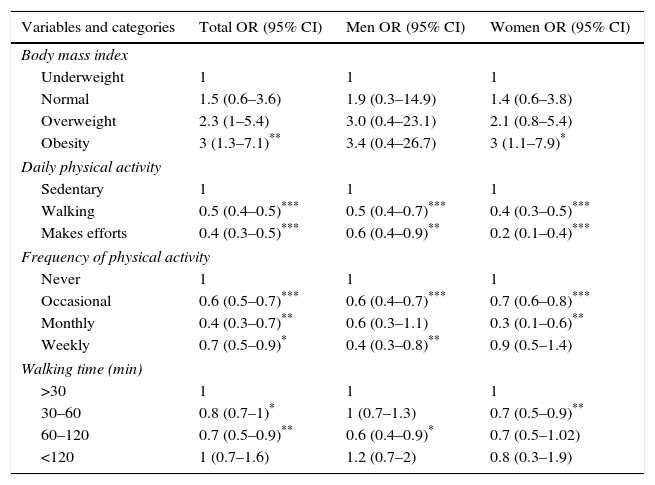To determine the prevalence of urinary incontinence in the elderly Spanish population of both sexes and identify a possible relationship between physical activity habits and the presence of urinary incontinence in the elderly.
Material and methodsWe used data from 8146 individuals older than 60 years (age range, 60–94 years), from which data from a 15-year cohort were obtained. Of these, 4745 (58.2%) were women and 3401 (41.8%) were men. We analyzed the presence of urinary incontinence, physical activity habits and the influence of other variables such as sex, age, weight and body mass index.
ResultsWe detected a prevalence of urinary incontinence of 15% for the women and 11.6% for the men. Those with urinary incontinence had a greater average age, weight and body mass index than the healthy participants. At the same time, the patient group with incontinence showed more sedentary habits compared with the healthy participants.
ConclusionsA strong relationship was observed between the body mass index and prevalence of urinary incontinence. Urinary incontinence was also related to attitudinal aspects such as physical inactivity, a behavior that predisposes the elderly to developing incontinence. For the first time, we observed a reduction in the prevalence of incontinence compared with previous studies.
Definir la prevalencia de la incontinencia urinaria en la población de adultos mayores españoles en ambos sexos e identificar la posible relación entre los hábitos de actividad física y la presencia de incontinencia urinaria en personas mayores.
Material y métodosSe utilizaron datos de 8.146 personas mayores de 60 años (rango de edad de 60-94 años), con lo que se obtuvieron datos de una cohorte de 15 años. De estos, 4.745 (58,2%) eran mujeres y 3.401 (41,8%) eran hombres. Se analizaron la presencia de incontinencia urinaria, los hábitos de actividad física y la influencia de otras variables como el sexo, la edad, el peso y el índice de masa corporal.
ResultadosSe detectó una prevalencia de incontinencia urinaria del 15% para las mujeres y del 11,6% para los hombres. Destacan la mayor edad, peso e índice de masa corporal promedio de los pacientes de incontinencia urinaria frente a los participantes sanos. Al mismo tiempo, en todas las variables relacionadas con los hábitos de actividad física, el grupo de pacientes con incontinencia muestra hábitos más sedentarios en comparación con los participantes sanos.
ConclusionesSe observó una fuerte relación entre el índice de masa corporal y la prevalencia de incontinencia utinaria. También se relacionó con aspectos actitudinales como el sedentarismo, conducta que predispone a las personas mayores a desarrollar incontinencia. Por primera vez, se observa una reducción en la prevalencia de la incontinencia en comparación con estudios previos.









